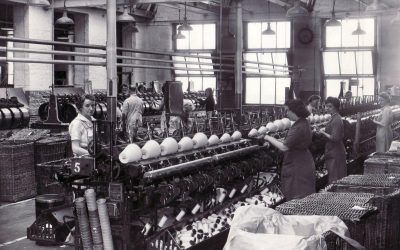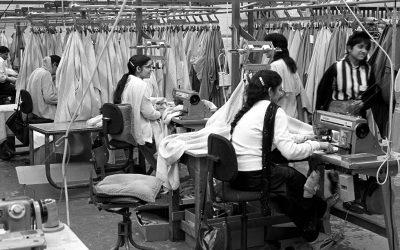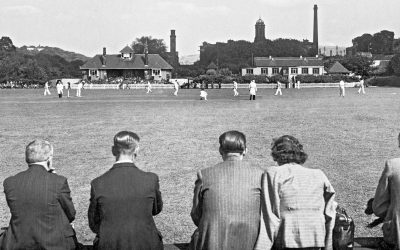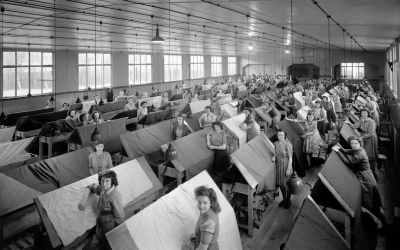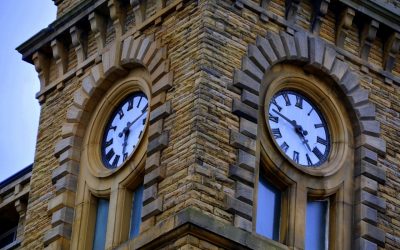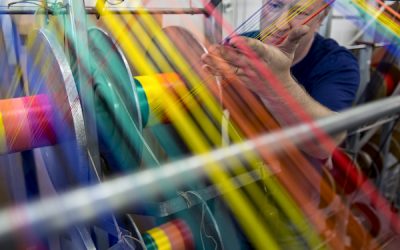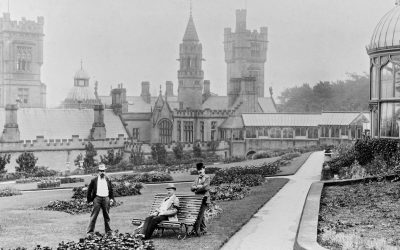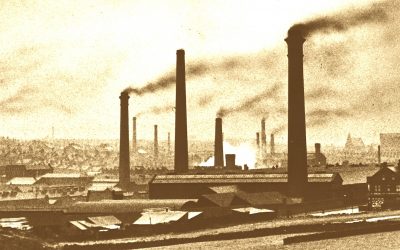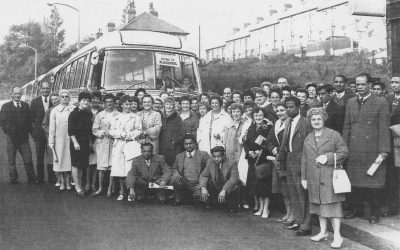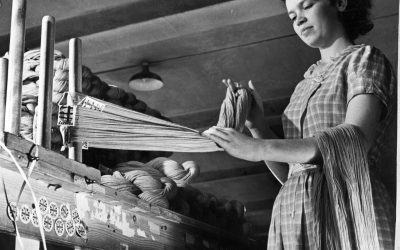I think what people should do is show an interest in local history because one day (and I hope this never happens) there won’t be people like you, and there won’t be people like me, who have a little knowledge, or a lot of knowledge that they want to pass on. And it might just slowly, over years, just decline where nobody will ask, ‘Oh, what was that?’
How to Use Oral History
You can use oral history techniques to explore all sorts of subjects. Here are some examples:
- Students in a school interview their teachers about why they chose to go into teaching and what their first day was like, and make a display in the hall.
- A local history group interviews residents of a particular area to find out what has happened over the years to create a booklet and make a presentation to the local community.
- A drama group collects stories of 1960s pop culture from older people to use as the basis for a music-theatre performance.
The subjects and themes are endless and the collected stories and memories can be fascinating and used in many ways.
There are a number of important things to do before embarking on an oral history project. This web page is designed to help start the process, but it doesn’t have all the answers. Read through our advice below, find someone local to talk to if you can and check out resources on the internet:
- National Lottery Heritage Fund – Practice Guidance for Oral History
- BBC – A Guide to Oral History
- The Oral History Society
There are many other places on the web to help you out – just search oral history guidance.
When I look back at the years I worked in the mills, I feel it was like a prisoner’s life. No living standard.
Making a Maternity Teddy out of Wool Scraps from Joseph Dawson’s
Sue Barton | Transcript
I was making a teddy bear for my baby to be, when I was pregnant. And I actually stuffed it with wool that would have otherwise been thrown away. And so I actually had a teddy bear that was stuffed with mohair and alpaca wool! It weighed a tonne! And it was probably worth quite a bit of money! But I have no idea where that teddy bear is now. I cut it out from fur fabric and sewed it up myself. And I was going to buy the stuffing, you know, the kapok. Then I was sort of throwing all this into the, you know, the bin where you put everything. And I just thought, ‘Oh, do you know what, why not?!’ It was a nice souvenir to take away when I went off on maternity.
Oral history is based on the collection of memories and stories from people about a specific theme or subject. For Lost Mills and Ghost Mansions, we interviewed and recorded over 80 people across Bradford who had worked in the textile trade. We did this because we wanted to find out about life in Bradford’s mills from people with first hand knowledge. Their true stories told us so much more than we could ever find out in other ways.
Describing British Mohair Spinners’ Fleece Mill, Keighley
Jayne Pickard | Transcript
Do you know where B&M is in Keighley? It was in there. You went through some big gates, and it went round and… All behind there was the mill. And it was a big courtyard with a cobbled street going up. And then you went down to your left and that took you into the main mill. But all those sorting sheds were as you went into the… through these big double gates, where [the] entrance to [the] car park is now. It’s hard to imagine now, but I can see it so vividly. And these big, big sheds. There must have been two or three on my right and then maybe two as you went left, all up there as you went and then you followed it round and into the main mill. But I only ever looked. I never went in, until many years, well, not many years, about five or six years later, and it was a shoe place. You still went up through the yard, but you went down some stone steps into the old mill itself. And it sold shoes. So that was so weird!
The wool mills of Bradford, once filled with the clatter of machinery and the vibrant chatter of the workforce, today sit empty, derelict or transformed into apartments. A far cry from the dyers, winders and twisters that filled the now empty mill spaces.
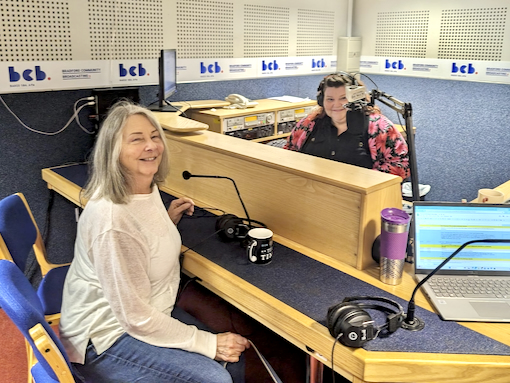
Photograph: Izzie Smith | Marie Millward interviewing Julie Fearn at Bradford Community Broadcasting
On the floor below me were a labourer and his name was Jack. And he lived on his own in Haworth. He didn’t know how to look after himself properly so he kept running out of electric and gas and all. So he didn’t have a fire and that, and he was always taking bobbins home, to burn in fire. Any broken bobbins and everything. He’d go around every room every day, and he’d come up to you, ‘Have you got any bobbins? You have any bobbins?’ That was his name; Jackie Bobbin we called him!
Step by Step
Getting Started
- Choose your subject or theme and write a description of what you are looking for.
- Identify the groups you want to speak to and how to get in touch with them.
- Think about the publicity you need. Leaflet? Email? Mailchimp? Social media? A press release for local papers, TV and Radio?
- Do the admin: prepare a spreadsheet (or list) with details of the people you need to talk to. Organise folders for interviews. Keep everything tidy as you go along. Work out what everything will cost and who’s paying for it.
Be Prepared
- Think about risks and how to be safe, particularly when you are interviewing people you have never met before.
- Make sure you have something to record your interview on. Most modern smartphones are good recording devices, but you can buy specialist equipment.
- Work out the questions you want to ask and how long the interview should be. Be prepared for unexpected stories and memories – they can be pure gold!
- Prepare an agreement that says what you are doing and what you will do with the interview. Include basic information – name, address, gender etc and how to stay in touch. The person being interviewed should sign and date the agreement. Include the name of the interviewer for future reference.
Recording an Interview
- Before you interview someone, explain what you are doing and why. If you have an information sheet, give them a copy. Try to use a quiet space that doesn’t have outside noises or an echo. Put them at ease and make sure they have signed the permission form before you press record.
- Interview technique is important. There are lots of dos and don’ts – but make sure you are clear, you don’t interrupt or make noises (no umms or ahhs or silly laughs) and try to keep the interview on track. Be polite and let the person you are interviewing do most of the talking. Here are some online resources for interviewing techniques:
YRDSB Museum & Archives – Conducting an Oral History Interview
National Heritage Lottery Fund – Learning to Listen for Oral History Interviews
- After the interview, make sure you store the audio file somewhere safe. It is always best to transcribe your interview into text – it makes it easier to review and manage. You can use online AI transcribers – they usually cost something but they save time. We have used Cockatoo and Clearvoice. Always check an AI transcription, they are getting better, but there will be mistakes. You can transcribe an interview manually, but it does take time.
- If you want to edit your audio, you may need some training. Local radio stations, community groups and amateur film makers might help. We use Audacity software, which is free and good for our purposes.
- What will you do with your recorded interviews? Make a book? A radio programme? Build a website? Do a live presentation? Whatever you do, make sure the right people find out about what you’ve done and the great results you’ve got – especially the people you’ve interviewed!
Things to do...

Collecting and sharing oral history helps preserve personal stories to enrich our understanding of historical events and cultural heritage. Everyone’s experiences deserve to be heard and those listening will all interpret them differently. The best thing is, anyone can do it! Here are a few more ideas on how to get started:
What to do next...
Volunteer at your local, community broadcasting station to learn practical skills in recording, interviewing, editing, and the power of storytelling. This project was in partnership with Bradford Community Broadcasting and they love working with new people with an interest in radio!
What to do next...
Interview an older relative or friend about the industry they work/worked in. Don’t be afraid to ask more questions to learn the technical side of the industry, especially if they use terms you don’t understand! This is a great way to connect with them and see their relevant industry in a new way.
Discover More
Lost Mills
Lost Mills & Ghost Mansions
Photograph: Tim Smith | UNSPUN How To Use The Learning Zone is a rich and fascinating resource for all. Take your time to explore and discover the many stories and insights on offer. Whether you are a student, a teacher, a researcher, a community group or an...
Working life
Photograph: Tim Smith | Lifting hanks of wool from a dyeing vat at Harrison Gardner and Company. If you've seen old mills, pictures of old mills and that, you'll see that there's a big mill with five or six storeys. And then at the back of it, probably, there's a one...
Diverse workforce
Photographs: Bradford Museums & GalleriesBackground: Bradford Museums & Galleries Photograph: Tim Smith | Combing at Haworth Scouring CompanyBackground: Bradford Museums & Galleries Photograph: Jaz Oldham | Jaz's Sister and Friend working in the mill The...
Time Off
Background: Bradford Museums & Galleries | Cricket Match in Saltaire Photograph: Jaz Oldham | Party in the MillBackground: Bradford Museums & Galleries | Cricket Match in Saltaire Photograph: Patricia Crabtree | Harold Heppleston, Patricia's Father, and...
Rights & Wrongs
Photograph: Val Rowland | Anwar Hussain (L), Bill Morris, former General Secretary of the Transport and General Workers Union (C), and Muhammad Rasab (R). Representing the racial discrimination case against John Haggas Ltd onstage at the Trade Union Annual Congress...
Changing Ways
Photographs: Mark Stevenson | Dalton Mill and Clock Tower I could see at that time that the mills were starting to close around Keighley all over the town and I thought ‘I need to be moving on somewhere’ and that's when I left in 1975 and joined the fire service....
Textiles Today
Background Photograph: Tim Smith | Laxtons' state-of-the-art spinning machinery in Baildon Title Photograph: Tim Smith | Weaving of Rainbow Ribbons at Wyedean Weaving in Haworth In 2022, I saw this job. And I rang them up and said ‘I’m looking for a job as a...
Ghost Mansions
I know that Robert Clough - he had a big mansion, and he donated a Christmas tree for the people of Keighley one year. Well, I won't be swayed on this at all. Particularly on a Friday night, when everybody else had gone home,...
Research & Map
Background Photograph: Bradford Museums & Galleries | Bradford's Skyline Title Photograph: Rainbow School | Visiting Bradford's Industrial Museum I grew up next to Marriner’s and I actually watched it burn down. It would have been in the ‘70s. I was in my...
Mediawall
Photograph: Margaret Dobson via Keighley and District Local History Society | Employees of John Haggas Ltd's Outing to Blackpool Lost Mills Media Wall Here we celebrate the rich visual history shared by contributors and project partners whilst researching Bradford's...
Archive
Photograph: Alan Dix | Lister's Mill ChimneyWelcome to the Lost Mills Archive. Here you will find all the recordings and transcripts that have been made during the lifetime of the project. It contains a wealth of information - far more than we could ever use in the...
Contributors
Thank you Lost Mills and Ghost Mansions has involved at least 500 people one way or another and their support, participation and commitment has taken us on a very special journey. Most of the people we interviewed were in their 70s and 80s and some were over 90. It is...
The contents of the 509 Arts website are protected by copyright unless otherwise stated. The Lost Mills Learning Zone recordings, text and activity suggestions are free to use for non-commercial community and education purposes. If you wish to use the materials for any other purpose, email info@509arts.co.uk with your plans.
Some of the images and video footage belong to a third party and are credited as such. If you wish to use any such content, please contact 509 Arts or the copyright owner directly.


